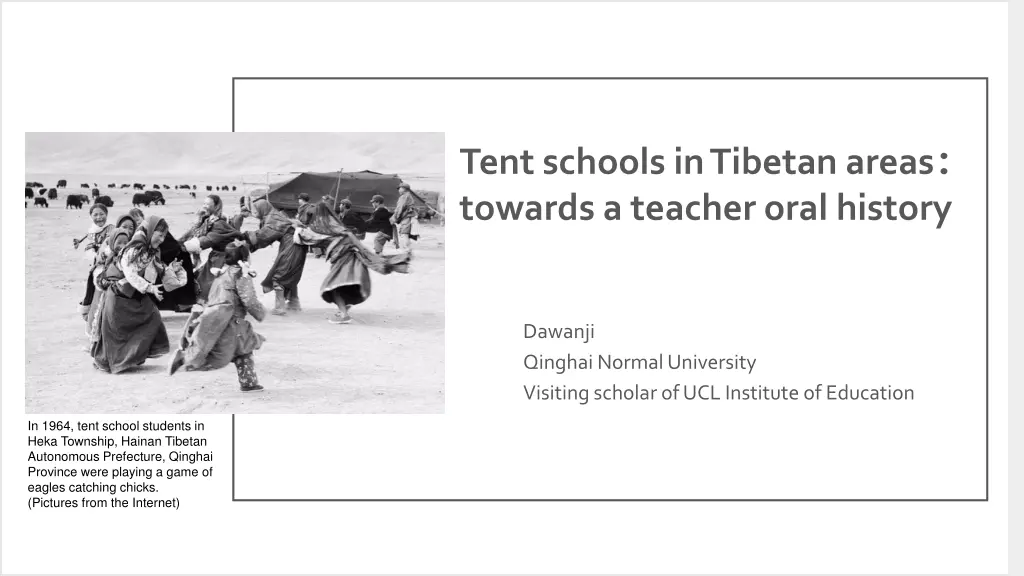
Exploring the History of Tent Schools in Tibetan Regions
Dive into the historical significance of tent schools in Qinghai Tibetan areas, focusing on their rise during the Cultural Revolution, the unique educational challenges faced, and insights from oral history interviews with former teachers. Discover how Tibetan Buddhist temple education intertwined with nomadic life shaped the educational landscape, highlighting the cultural relevance and student outcomes.
Download Presentation

Please find below an Image/Link to download the presentation.
The content on the website is provided AS IS for your information and personal use only. It may not be sold, licensed, or shared on other websites without obtaining consent from the author. If you encounter any issues during the download, it is possible that the publisher has removed the file from their server.
You are allowed to download the files provided on this website for personal or commercial use, subject to the condition that they are used lawfully. All files are the property of their respective owners.
The content on the website is provided AS IS for your information and personal use only. It may not be sold, licensed, or shared on other websites without obtaining consent from the author.
E N D
Presentation Transcript
Tent schools in Tibetan areas towards a teacher oral history Dawanji Qinghai Normal University Visiting scholar of UCL Institute of Education In 1964, tent school students in Heka Township, Hainan Tibetan Autonomous Prefecture, Qinghai Province were playing a game of eagles catching chicks. (Pictures from the Internet)
Introduction The rise and fall of the tent schools Started to build tent schools in Qinghai Tibetan pastoral region. Amid the Cultural Revolution (1966-1976), the quantity of tent Schools in Qinghai reached an unprecedented level. 1958 1976 1980 1949 1952 1962 1966 The Provincial Education Policy for Minorities encouraged the establishment and operation of tent schools. Tent Schools began to be abolished or replaced by boarding School. The founding of the People's Republic of China. Previous research Little scholarly attention has been paid to it in the study of history of Tibetan education. Few Chinese scholars mentioned it in relevant literature, but it is limited to a brief introduction and believed that tent schools were "against the teaching rule" and "poor teaching".
Historical context 3.Nomadic life 2.Cultural mentality 1.Tibetan Buddhist temple education Tibetan Buddhism has an inviolable and sacred status in Tibetan society. The belief of Buddhism is deeply embedded in the Tibetans outlook on life and social behavior. Tibetan pastoral nomads make a living from animal husbandry, and have long since continued their primitive nomadic mode of "choosing the place which around water and grass to live". Tibetan Buddhist temple education is the only form of education in Tibetan area for as long as four centuries. "There is no school outside the monastery, and there is no teacher except for monk."
Methodology This study draws on data from oral history interviews with 10 teachers who worked at tent schools in Qinghai Tibetan area from the 1960s to the 1970s. Here we focused on Qinghai, the biggest Tibetan inhabited area next to the Tibet Autonomous Region (TAR), with nearly one-fifth of the Tibetan population. we are concerned with the relatively short period from the 1960s to the 1970s, a very important time involving the peak number of tent schools. Our participants includes 8 men and 2 women, their teaching time in tent school was 14 years at most and 1 year at least. For both epidemic and geographical reason, we conducted online interviews with 8 of the teachers via WeChat.
Current findings 1.School form: symbol of pastoral education Rather than saying that a tent is an teaching space, it is a symbol of education that can bring nomadic children together. 2.Education time: order in the loose Influenced by nomadic life and the way tent schools were usually managed by only one teacher, there were no strict timetables or a clear time for the start and end of the term. However, teachers sought to establish order. 3.Teaching content: culture-related The official textbooks and reading materials some teachers used in class showed the relevance and connection between the teaching content and the Tibetan culture. 4.Students choices after graduation: temples and schools It not only maintained the relationship between the monastery and the Tibetans, but also provided basic education for the teachers of Tibetan education in the following years.
